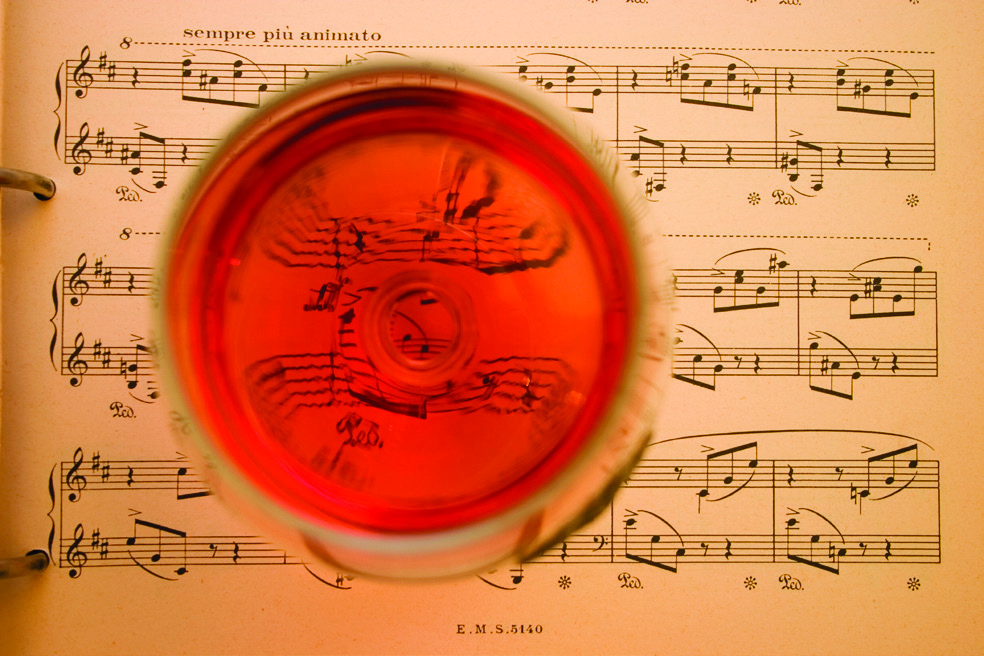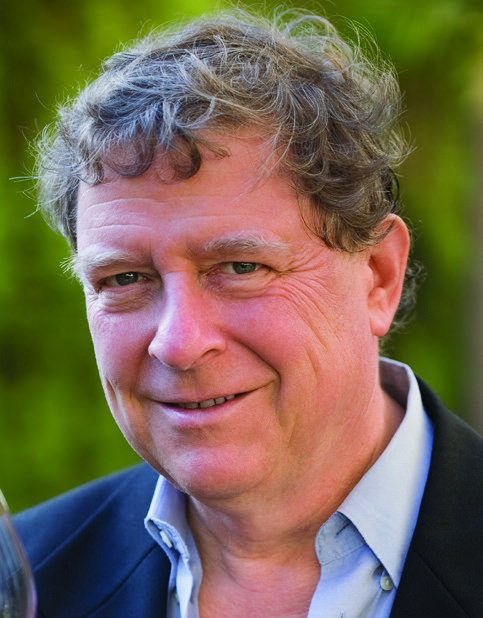The Intersection of Wine & Music

Let’s say you open a fine bottle of Burgundy and it’s OK but not as delicious as you hope. What can you do? It’s not like food, where you could add hot sauce or a little salt. But there is a step you can take: change the background music.
If you want the wine to taste richer, play music with a deeper bass line. If you want it to taste fresher, try playing something high-pitched.
Taste and sound interact. This makes intuitive sense; consider whether you would rather drink your fine Burgundy at an active construction site or in a rural meadow. And we already know that other senses, notably vision, affect how things taste. University of Oxford experimental psychologist Charles Spence has shown that strawberry mousse is perceived as 10% sweeter when eaten from a white container instead of a black one.
Considering the amount of money spent in tasting rooms, it’s surprising that there hasn’t been more research into the correspondence between music and wine. It’s something wineries think about, but generally in terms of ambience, not the actual taste of the wines. However, there is enough research to prove that music does affect how your wine tastes, and moreover it’s easy to prove to yourself that it does. We’ll give you a little experiment at the end of this story, but there’s wine so don’t think of it as homework.
Wineries have been playing music to their barrels for at least two decades; some say they think the music might influence the wines, while others, like Chile’s Aurelio Montes Jr., believe it will have a positive effect on the winery workers.
But the idea of actually pairing music to affect the taste of wine appears to date to 1998. Don Blackburn, then the winemaker at Bernardus in Carmel Valley, California, poured three different Chardonnays at a symposium, played 10 different pieces of music, and asked the attendees to choose which piece went with which wine.
One of the attendees at that symposium was Clark Smith, a maverick winemaker and wine technology consultant who is best known for his work on alcohol reduction. Smith set out to prove that music affects wine, sampling 150 different wines with 250 different songs until he came up with a convincing presentation that he could share with others.
It was, indeed, convincing. I believe I was the first person to write about Smith’s discoveries, in 2007 for the San Francisco Chronicle. But I won’t be the last, as Smith is currently working on a book about music and wine pairing with philosophy professor/wine blogger Dwight Furrow.
Smith won me over with a simple demonstration of two songs with two Chardonnays: a Glen Ellen California Chardonnay that, tasted in silence, I described as “a light and sweet airline wine,” and a Rombauer Carneros Chardonnay that I called an “oaky butter bomb.” I didn’t really like either. He played the Beach Boys’ California Girls and suddenly the Glen Ellen wine was brighter and more lemony, and I liked it. Then he played Ella Fitzgerald’s St. Louis Woman, a rollicking blues song, and the Glen Ellen wine tasted like a sour candy while the Rombauer was fat and rich with a long finish, and easily the better of the two.
Spence brought this idea into an academic setting. In 2012 he did a study about pairing classical music with wine, asking subjects to decide which piece went best with which wine. Dr. Jo Burzynska, a sound artist and wine writer in New Zealand, decided to go deeper, making the correlation of wine and music her doctoral research topic. Burzynska and Spence first worked together on a study of how low-fre-quency sounds affect the perception of wine.
“A low-pitched tone basically made people perceive the body of a Pinot Noir to be fuller,” Burzynska told Quench. “It increased the weight of a Pinot Noir in a statistically signifi-cant manner.”
“With high pitches, in research that pre-ceded mine into general flavor, robust associ-ations had already been found between high pitches and sour taste,” Burzynska said. “You can amplify acidity in wine by high pitches. But some people didn’t like the fact that their wine became a lot more crisp.”
Burzynska said she did a demonstration in 2017 in which she poured Pinot Noir with a variety of music.
“I included a piece of dubstep music that had huge bass. It turned it almost into a Shiraz,” Burzynska said. “That’s not what I like in my Pinot Noir. But someone came up to me and said they liked that one the best. I asked what kinds of wines he likes, and he liked richer wines.”
Tone is not the only important aspect, Burzynska says: timbre matters as well, especially in perceived mouthfeel.
“If I’m drinking a rich Chardonnay, I’ll go for something with a rich timbre,” Burzynska said. “If I’m drinking a Riesling, something edgy would be the order of the day. Special wines, special meals, I think about what I’m going to listen to because I know how much it affects the experience.”
With Cabernet Sauvignon, Smith recommends music with darkness to it, and in fact he thinks all red wines benefit from a little dark-ness in the music; his demonstrative example was The Doors’ People Are Strange. Burzynska prefers ambient music with Cabernet.
“The matching of intensities is important,” Burzynska said. “I’ve done some things with really bombastic pieces of music that really overpower even Cabernet. If you have a young Cabernet that’s a little angular, I might put on Brian Eno’s Discreet Music.”
Burzynska says that if you intuitively think a piece of music might go with a wine, based on its tone and timbre, you might be right: try it out. But she says restaurants that play the music they like without regard for the cuisine or wine are making a mistake.
“In Sydney, a restaurant opened which was Japanese food and grunge music,” Burzysnka said. “People who didn’t have the same back-ground as me were complaining that they don’t go together. The Japanese food is so delicate and the music overpowered it.”
Burzynska composed a lovely piece of music to go with Central Otago Pinot Noir: it opens with birdsong and brings in slightly mournful cello, giving it both light and dark-ness. She also founded a Christchurch wine and sound bar, The Auricle Sonic Arts Gallery, where sound installations played upstairs and patrons drank wine downstairs. She created a new playlist each month to go with the wines on offer.
Large companies have dipped their toes into this kind of pairing as well. Pre-pandemic, Krug Champagne house invited musicians each year to visit, taste Champagne, and write pieces based on their impressions. Krug has made these pieces available online under Krug Echoes, so you can test them out for yourself. Krug also worked with Chilean composer Roque Rivas to create 10 soundscapes to com-plement the 10 main components of its Cham-pagne, and has a sound installation in the Krug Family House where visitors can experience it with a 360-degree ambisonic system.
Kosta Browne, the high-end Sonoma County Pinot Noir producer, likes to describe its wines in musical terms. This makes sense, as three researchers at Universidad Nacional de Quilmes in Buenos Aires published a paper in 2011 showing that different musicians, when asked to represent tastes like “bitter” and “salty” with musical improvisations, con-sistently created similar riffs. Kosta Browne winemaker Julien Howsepian says he often thinks about specific songs when he’s tasting wines in barrel.
“The ‘17 Cerise (Vineyard) Pinot Noir was a song called Under the Pressure by The War on Drugs,” Howsepian said. “The first 20 seconds are an interesting reverberating electronic acoustic sound. Then a little synthesizer comes in the background. Then the beat drops. When I think of Cerise Pinot, it’s not the typical Kosta Browne wine. It’s a little more fringe, a little more ethereal. You open it and think, this might be a little different from what I’m expecting. Then you take a sip and say, I really like this. I think it’s a 3 or 4 minute song condensed into a glass of wine.”

In fact, researchers have long described a phenomenon known as synesthesia, in which some people experience sounds or flavors as colors. That’s an extreme example, but research like Spence’s and Burzynska’s seems to show that we all experience some level of sensory crossover. And not just with wine.
Jack Daniel’s whiskey started a pre-pandemic project that it plans to pick up again soon, in which musician Carlos Calvo plays live riffs on the guitar that accompany different bottlings.
“There was a lot of science backing that sound and tone affect your palate,” said Jack Daniel’s brand ambassador Eric Tecosky. “We looked at each other and said, yeah, it’s there, but it’s really boring. You can’t bring this to a tasting. People aren’t going to get excited about research about how your brain reacts. Our knee jerk reaction was to find songs that fit different expressions of Jack Daniel’s. Like, Whole Lotta Love seems to fit Single Barrel. But they didn’t write that for Jack Daniel’s. We wrote riffs for each expression of the whiskey.”
Tecosky said the riffs are about 45 seconds long, and they haven’t recorded them because “we’re trying to avoid a Zoom performance.” He expects the music and whiskey roadshow to resume soon.
I promised you something you could test at home. I’m not a fan of Frank Sinatra but when I did my first article on this in 2007, Smith suggested the best album I could buy for sparkling wine was Sinatra’s Songs for Swingin’ Lovers! I bought it and have been using it ever since; if a bubbly is a little underwhelming, that album brings out the, well, bubbliness: it’s cheerful without being insipid, which is just what you want from Prosecco or Cava. Try it, especially the song You Make Me Feel So Young.
And I also urge you to try your fine Cabernet with The Beach Boys, and then with The Doors. You’ll see – or should I say, you’ll taste.
This article originally appeared in the Fall 2021 print issue of Quench Magazine.
